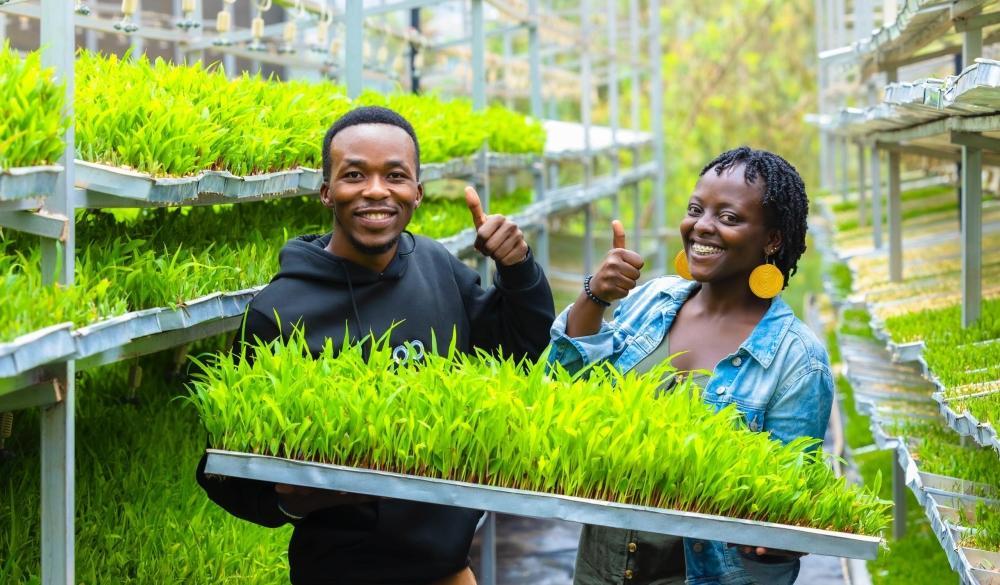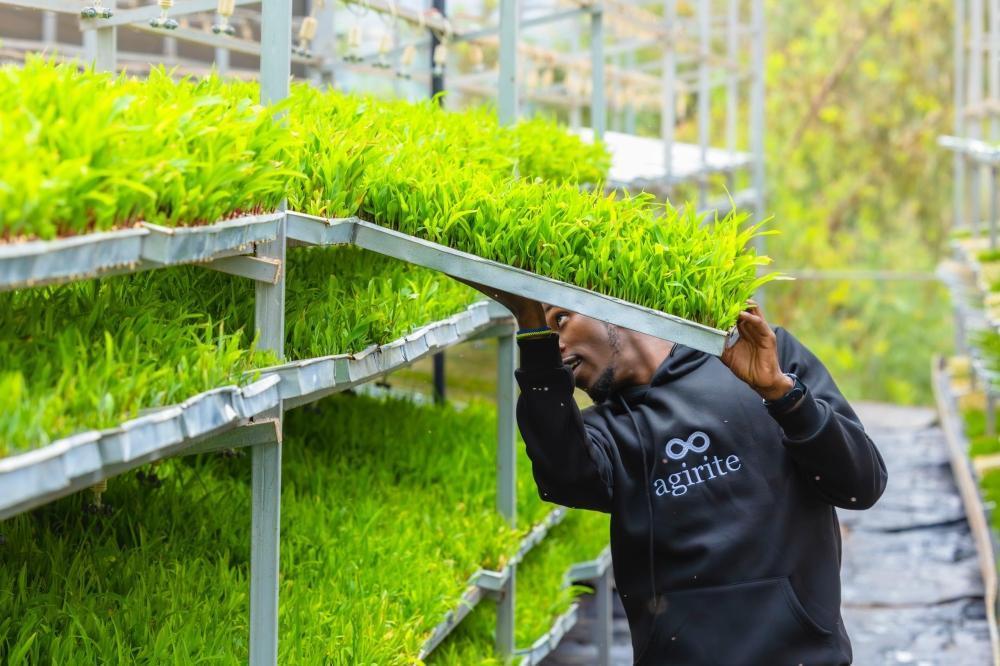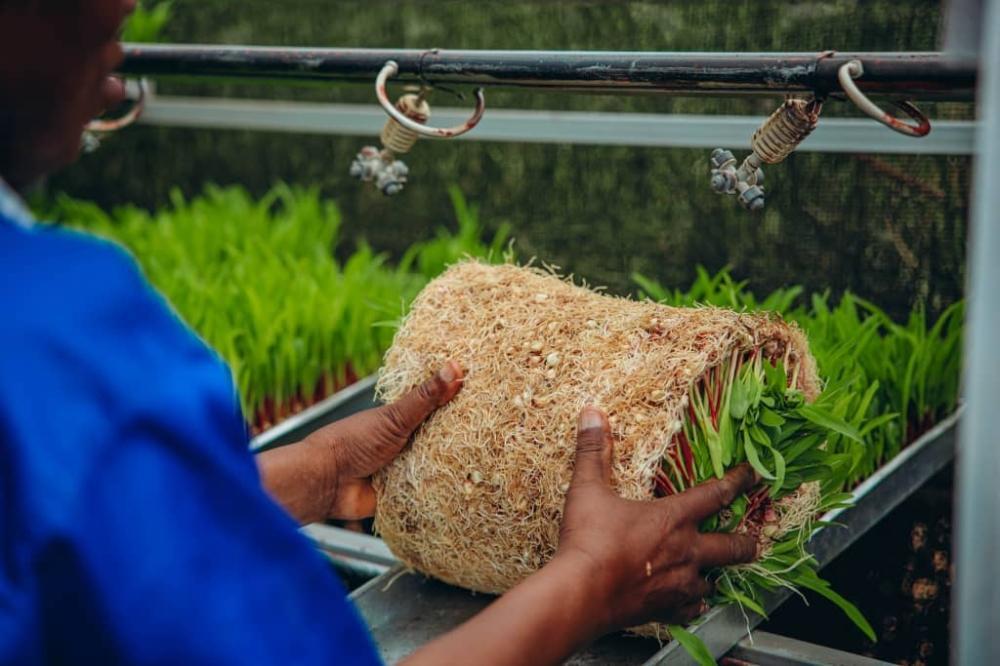Alice Kayibanda
Africa-Press – Rwanda. Beatrice Bakundukize plays with her daughter outside their new home in Ngororero, after giving her a bath, made easier by the addition of a water tank now installed at their home. In her previous home in Kabaya village, which was devastated by a landslide, access to water was once a rare luxury.
While her new home offers safety and comfort, a new challenge emerged: her farm is a three-hour walk away, making it nearly impossible for her to care for her goats. Her current village is surrounded by neighbours’ wheat fields, making it difficult to collect fodder, especially with the added responsibility of caring for her young children. As a result, she entrusted her goats to a friend, who agreed to look after them in exchange for one goat as compensation.
As a photojournalist documenting the lives of farmers, I have witnessed the significant impact of such hardships, especially on women-headed households. According to the Integrated Household Living Conditions Survey (EICV7), 61.6% of workers are employed in the agriculture sector. At the same time, the scarcity of arable land necessitates innovative solutions.
One promising solution is the introduction of hydroponic fodder production. Introducing hydroponic fodder production to farmers in Green Villages is essential for addressing limited land availability and preserving land for vital food crops. By adopting hydroponics, we can empower farmers, enhance their incomes, and promote sustainability, while ensuring food security in our community.
Hydroponics involves cultivating plants without soil, using nutrient-rich water. This method requires minimal water and space; 12 square meters can feed up to ten cows, allowing nutritious livestock feed to be grown in just seven days.
In light of Rwanda’s diminishing agricultural land and the pressing need for climate-resilient solutions, hydroponics offers a smart, scalable approach to maximizing land use and ensuring sustainable food production. The Livestock Development Strategy 2024-2029 (LDS) highlights that the rapid population growth exerts pressure on available land resources, leading to the progressive fragmentation of land parcels.
According to the LDS, land holdings per household are estimated at 0.4 ha, which is a reduction from 0.6 ha in 2012. Additionally, the 2021 State of Environment and Outlook Report highlights a daunting reality: to meet projected food demand by 2050, Rwanda would need land equivalent to four times its current size—a clearly unattainable target given the country’s geographic limitations.
Hydroponics involves cultivating plants without soil, using nutrient-rich water. Courtesy
This stark projection underscores the urgent need to adopt sustainable and innovative agricultural practices to close the gap between food demand and land availability. Hydroponics not only conserves valuable farmland for essential food production but also addresses key drivers of soil erosion, specifically overgrazing and deforestation for pasture.
Rwanda’s milk demand is increasing at an estimated 6% annually. However, recurrent droughts have hindered production, resulting in an output of one million tonnes in the 2023–2024 fiscal year, falling short of the 1.1 million-tonne target. In green villages, where residents often keep livestock in limited spaces, there is significant potential to adopt hydroponic systems for producing high-quality animal fodder. This innovation can significantly improve the nutritional intake of livestock, particularly dairy cows, helping maintain steady milk production even during climate-related feed shortages.
Additionally, green villages can support the rearing of other livestock, thereby increasing access to protein-rich food such as meat. By integrating hydroponics into smallholder farming systems, communities can develop a more sustainable livestock value chain.
In the Eastern Province, hydroponic fodder production is helping smallholder farmers improve their livelihoods. In Gatsibo, dairy farmer Christophe Ndemezo boosted his cows’ milk production from 45 to 65 liters per day using hydroponic feed, significantly raising his earnings.
In Bugesera, members of the KOAKU cooperative doubled their milk yields after adopting hydroponic barley fodder. In Ngoma, farmer Justine Habimana used a 12-square-meter hydroponic setup to feed his pigs, enabling him to sell a piglet for Rwf220,000 in just seven months. Similar systems could offer a reliable way for residents of green villages to boost productivity and income.
Many may argue that the initial setup costs, limited skilled labor, and environmental control challenges hinder the widespread adoption of hydroponic systems. However, local cooperatives are tackling these barriers. For instance, the Uruhimbi Kageyo Cooperative, which received a grant from UNDP, has implemented low-cost hydroponic systems in Gicumbi using locally available materials.
Introducing hydroponic fodder production to farmers in Green Villages is essential for addressing limited land availability and preserving land.
The cooperative now sells hydroponic fodder at varying prices depending on the type of livestock. This model demonstrates how cooperatives can promote sustainable practices while generating income and improving resilience for smallholder farmers.
Beatrice’s challenge is not unique. Residents of the Rwinkuba Green Village, relocated from Busorongo Island, faced a similar situation. Despite owning cows, they struggled with low milk production due to limited access to animal fodder. The cost of maintaining their livestock became a burden, as they were unable to generate sufficient income from the milk. These experiences underline the urgent need for sustainable fodder solutions like hydroponics.
Local cooperatives specialized in hydroponics offer a significant opportunity for advancing hydroponics in Rwanda. Investing in them would foster community development, reduce costs using local materials, and build valuable skills within the community.
Green villages offer a unique opportunity to further this effort, as they already possess the necessary infrastructure, including sheds and water tanks, as well as supportive community structures. When villages lack sufficient space for growing animal fodder, the Government and its stakeholders could integrate hydroponic systems into the village design, ensuring that they are tailored to maximize productivity and efficiency.
Implementing hydroponics in these settings can enhance the livelihoods of individuals relocated there, providing them with a reliable source of income through the sale of fresh produce. This approach not only addresses food security but also empowers residents economically, enabling them to contribute to their families and communities.
Alice Kayibanda is a photojournalist and part of communication team at UNDP Rwanda. Through her visual storytelling, she sheds light on social issues and aims to foster empathy and understanding.
Source: The New Times
For More News And Analysis About Rwanda Follow Africa-Press








